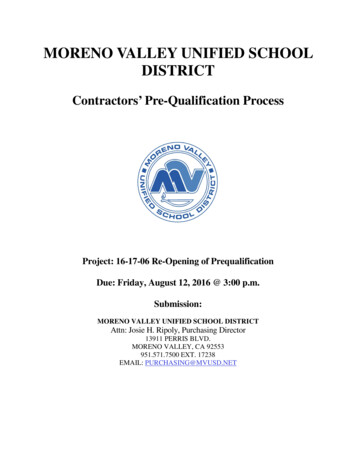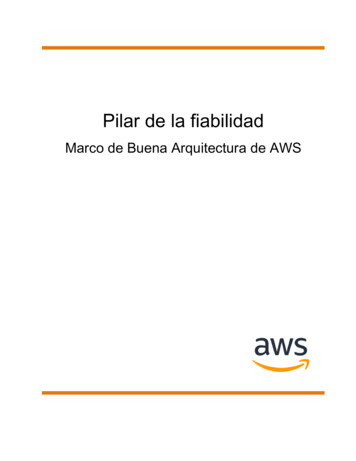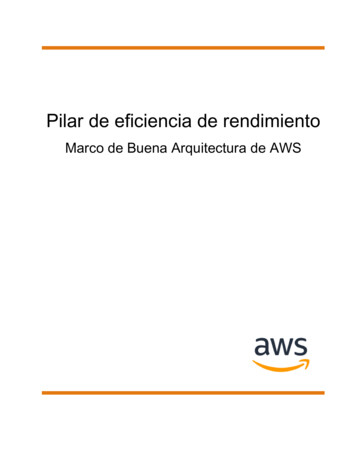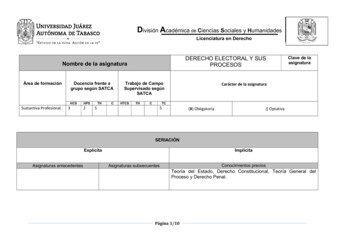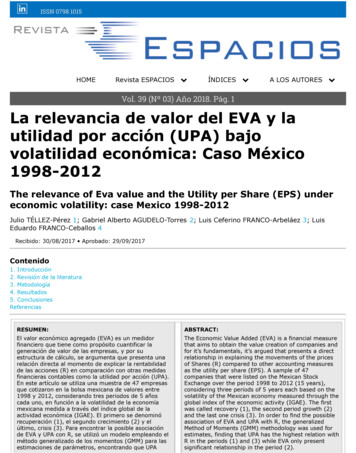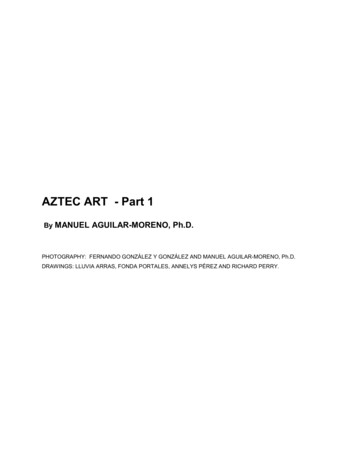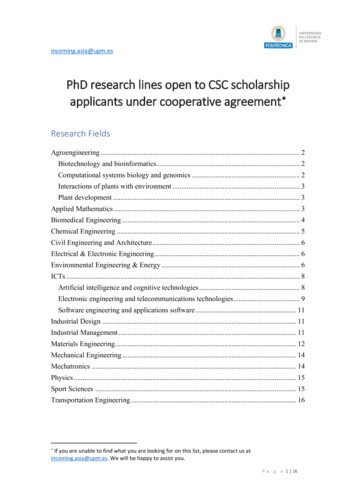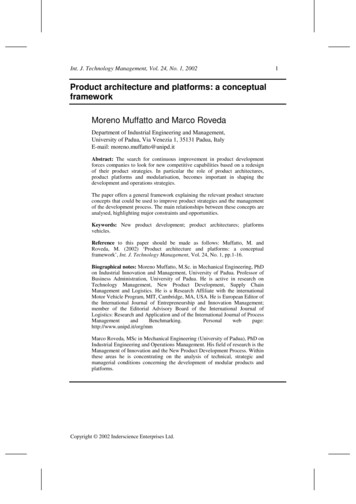
Transcription
Int. J. Technology Management, Vol. 24, No. 1, 2002Product architecture and platforms: a conceptualframeworkMoreno Muffatto and Marco RovedaDepartment of Industrial Engineering and Management,University of Padua, Via Venezia 1, 35131 Padua, ItalyE-mail: moreno.muffatto@unipd.itAbstract: The search for continuous improvement in product developmentforces companies to look for new competitive capabilities based on a redesignof their product strategies. In particular the role of product architectures,product platforms and modularisation, becomes important in shaping thedevelopment and operations strategies.The paper offers a general framework explaining the relevant product structureconcepts that could be used to improve product strategies and the managementof the development process. The main relationships between these concepts areanalysed, highlighting major constraints and opportunities.Keywords: New product development; product architectures; platformsvehicles.Reference to this paper should be made as follows: Muffatto, M. andRoveda, M. (2002) ‘Product architecture and platforms: a conceptualframework’, Int. J. Technology Management, Vol. 24, No. 1, pp.1-16.Biographical notes: Moreno Muffatto, M.Sc. in Mechanical Engineering, PhDon Industrial Innovation and Management, University of Padua. Professor ofBusiness Administration, University of Padua. He is active in research onTechnology Management, New Product Development, Supply ChainManagement and Logistics. He is a Research Affiliate with the internationalMotor Vehicle Program, MIT, Cambridge, MA, USA. He is European Editor ofthe International Journal of Entrepreneurship and Innovation Management;member of the Editorial Advisory Board of the International Journal ofLogistics: Research and Application and of the International Journal of ttp://www.unipd.it/org/mmMarco Roveda, MSc in Mechanical Engineering (University of Padua), PhD onIndustrial Engineering and Operations Management. His field of research is theManagement of Innovation and the New Product Development Process. Withinthese areas he is concentrating on the analysis of technical, strategic andmanagerial conditions concerning the development of modular products andplatforms.Copyright 2002 Inderscience Enterprises Ltd.1
21M. Muffatto and M. RovedaIntroductionIncreasing worldwide competition between companies has focused attention on themanagement of processes that enhance the value of the product for the customer. Forcompanies this implies renewing and refining their innovation capabilities. In particular,the product development process has to ensure productivity while at the same timeguaranteeing that products meet customer expectations in terms of technical performance,innovation and time of delivery.To achieve this, companies must make decisions regarding product variety,standardisation and customisation. For this reason companies need to assess their productstrategy in order to evaluate the importance of the definition of product architecture,platforms, modularisation and standardisation.A redefinition of product strategies, based on different product structures has animpact on product development performance, development phasing and organisation,relationship with suppliers, globalisation of R&D and operations. As far as productdevelopment performance is concerned, the product structure influences time, cost,product quality and variety [1-7].Time is the first relevant issue. The case of the computer industry shows how sales ofpersonal computers have grown consistently in recent years thanks to the modularisationof their architectures. This allowed personal computers to be developed much morequickly yet reaching mainframe performances standards, that were instead developedwith ad hoc designed hard disks, RAM, mother boards and even operative systemsoftware [5].Regarding costs, they are mostly tied to the economies of scale that companies setand exploit. Redefining product structures heavily affects this aspect because it enablesthe sharing of more components among different products so achieving bigger productionvolumes for each of them. Furthermore products built up on flexible structures can bemore flexibly managed and produced, for instance externalising some phases ofproduction.Quality is another aspect of performance. A variation in product architectureinfluences first of all the perception of products by the customers. Furthermore otheraspects of quality, like component reliability, depend upon choices on product structures,because standardisation can be more or less implemented according to architecturesetting.Nonetheless the actual market needs mean that companies have to offer an increasinglevel of variety (or external variety [8]). Consequently a wide ranging combination ofproduct parts and components must be developed, from which thousands of variants canbe obtained [9].The relationship with partners and suppliers also depends on decisions about productarchitecture and platforms. The modification of task partitioning in new productdevelopment [10] and variations in the number of standard parts in a product involvesuppliers’ role in the innovation process. As far as the globalisation of R&D andoperations are concerned, the influence of product structures can be seen in the allocationof development and/or manufacturing/assembly tasks on a global basis.The second relevant issue in this paper will be the adoption of platforms in the NPDprocess. Several authors [1,2,6,9-17] have already looked at topic showing how platformsheavily influence the product development performances. In particular the innovationpace and development lead-time are the first to benefit from a platform strategy adoption.
Product architecture and platforms: a conceptual framework3One of the issues still being discussed in literature is how to provide a definition ofplatforms good enough to be applied in different industrial contexts. Indeed in literature itis possible to find out, on the one hand, definitions sounding extremely technical andseldom product/industry-specific (narrow definitions; e.g. [15,18,19]). On the other hand,some definitions aim at encompassing different industries and innovation processes, butresult in highly generic and abstract (broad definitions; e.g. [16,20-22]).For our purposes, it is enough to choose a definition generic enough, in order toencompass most of the important elements a product platform adoption arises. At thesame time the definition should be flexible and also able to be understood bypractitioners. Consequently, basically consisting of Meyer’s definition [6,20], in thefollowing paragraphs we will assume: a product platform is a set of subsystems andinterfaces intentionally planned and developed to form a common structure from which astream of derivative products can be efficiently developed and produced.2Theoretical backgroundThe relationship between product structure and product development strategy must beseen in the context of several related concepts such as: product functions, productarchitecture, modules, platforms and product families. It is also very important to takeinto account the opportunities and constraints of the manufacturing and assemblyprocess. Various authors have discussed these concepts in the literature and some of thesebasic definitions are referred to.The functions in a product are defined as “what the product does as opposed to whatthe physical characteristics of the product are” [4]. In this sense, it is possible to extendthe application of the definition to subsystems and components of the product itself. Thedefinition of function is a prerequisite for defining a module.The latter is a part or a subassembly forming a closed function unit, with well definedand often standardised interfaces (geometry, function) which can be developed,manufactured and assembled independently of the rest of the product [3-5,19,23,24].Modules differ from generic components which are “any distinct region of theproduct, including also a software subroutine” [4]. Modules can be easily interchangedwith one another, for instance, to customise products or to make them perform differentfunctions.Product architecture is “the scheme by which the function of the product is allocatedto physical components” or “the arrangement of functional elements; the mapping fromfunctional elements to physical components; the specification of interfaces amonginteractive physical components” [4]. A typology for product architecture may be givenas follows: architecture can be integral or modular, but in the latter situation a furtherdivision is possible between slot, bus or sectional modular architecture. Ulrich alsodiscusses the relationship between product architecture and managerial problems relatedto product strategy. In particular he addresses problems related to product changes,product variety, component standardisation, product performances and productdevelopment management.Anyway we see a limitation in using the term integrity as architectural conceptopposed to modularity. Indeed it refers both to the perception that customers get of theproduct [11] and to a concept characterising the architecture of products [3,4]. What is
4M. Muffatto and M. Rovedasomewhat misleading is that ‘external’ integrity (the concept expressed by Clark andFujimoto [9]) should be sought for also in typically modular products. This generates anapparent contradiction with the definition of integrity as an architectural concept(i.e. complex mapping between functions and components, coupling of interfaces). So wethink it is more useful to talk about architectural complexity.The concept of the platform has been receiving increased attention in productdevelopment and operations management. Several authors have recently been concernedwith the platform concept [2,6,15,22,25]. One broad definition of the platform is“a relatively large set of product components, physically connected as a stablesub-assembly and common to different final models” [6]. From a broader perspective theplatform can be considered as a collection of assets shared by a set of products. By usinga platform approach a company can develop a set of differentiated products or derivatives[2]. The definition of the product platform provided by Meyer and Utterback [15], is evenbroader and related not only to a product’s technological features or to its physicalstructure, but also takes into consideration the contributions which other functions of thefirm make such as marketing, distribution, service and manufacturing. Sharing processesor distribution channels or marketing efforts, is a broader viewpoint in which to considera platform. Meyer [22] extends the platform definition to include possible commonalityin processes, for instance production. Indeed the definition is focused on the efficiency ofthe development and production of derivative products, so that a platform can exist notonly when products share physical components but processes as well. In particular fromthe production and assembly perspectives a platform implies a focus on commonality ofproduction tools, machines and assembly lines. As a consequence, some companies in theautomobile industry have considered it more interesting to define a platform more on amanufacturing-assembly basis rather than on a product development basis to betterexploit commonality among models in the production process [19,26]. Modular concepts,applied to the assembly process, can revolutionise industries traditionally based onintegral products [23]. A clear example regarding the automobile industry is described inKinutani [27].The platform can also be seen as an organisational structure. From an organisationalviewpoint, a platform offers a means of developing a cross-functional team withinproduct development for the integration of product components [17,20]. The benefits andconstraints of the platform concept must also be seen from a multi-product perspective[12]. In fact, the product platform must assure product integrity while also exploitingsome of the advantages of modularisation and standardisation. For these reasons productsmust be seen as part of a family. In some industries the ‘family feeling’ of products is oneof the most important characteristics for market success [11]. The multi-productperspective consists in the strategy of defining product features to offer a range ofalternatives, which defines the product family boundaries. This definition is compatibleto that of the product family given by Meyer and Utterback [15]. A product familytypically addresses a market segment, while specific products or groups of products,within the family, target niches in that segment.Finally, several contributions already focused on the analysis of platformdevelopment in the automobile industry [9,25,28]. In particular, Cusumano and Nobeoka[25] elaborated a model that classifies different types of platforms according to thevariation of two indexes based on the commonality of dimensional parameters (track andwheel distance) and of technical features (suspension types). Wilhelm [19] reports thesuccessful case of implementation of the platform strategy in the automotive industry
Product architecture and platforms: a conceptual framework5taking into account the main influence of this kind of strategy both on the productionprocess and the producer-supplier relationship.3Research aim and methodologyThe primary aim of this paper is that of contributing to the growth of existingterminology in this field and easing consensus upon the meaning of concepts. Theconditions which make it possible to employ architectural concepts in productdevelopment will then be examined on the basis of a broad literature review. Conceptsare then connected to one another through literature evidence and some examples drawnfrom specific research carried out by the authors, in order to discover mutualrelationships between concepts themselves. In particular, the connection betweenarchitectures and platforms will be examined, because of the scarcity of works analysingthis particular matter. The final goal is given by the creation of a theoretical framework,in which concepts are related to one another, which should represent the basis for a futurecollection of empirical research findings to support the schematic. Since the majority ofexamples concern industries where products structures are based on a robust mechanicalframe (e.g. vehicles), the validity of this theoretical analysis is limited essentially to thoseindustries.4The frame of referenceOne of the aims of the research presented here is to highlight the relationship that affectsthe concepts previously defined. Not much can be found in literature regarding this.Furthermore past works haven’t analysed how applying a platform approach to the newproduct development process can be influenced by product architecture. Productdevelopment strategies, product and production technology and the organisation of theproduct development process have an impact on platform development. The modelrelates the concepts of product requirements, product functions, architecture, modules,and platforms to one another.The model presented in Figure 1 is a first attempt to correlate concepts concerningtechnology, product structure and strategy. A detailed explanation of the relationshipsbetween the concepts is presented in this section. Then examples will be given withreference to various products. Subsequently, this model will be used to analyse someproducts from the vehicle industries. It’s worth noting that the scheme starts withcustomer requirements (thus from a market perspective).The choices regarding architecture and platform are influenced not only by productstructure, but also by technological constraints and product strategies. This analysis hasbeen limited to the technical and strategic aspects of product development.Organisational issues are beyond the scope of this research project.
6Figure 1M. Muffatto and M. RovedaThe frame of reference4.1 Requirements-functionsDefining the functions performed by a product is not as straightforward as it appears atfirst glance. The analysis could be carried out at really different levels, with differentresults.Let’s consider for example a car. Its basic functions, in a final user perspective, couldbe those of assuring motion, transporting people and goods/luggage on roads, with anaccepted degree of quiet, driving position comfort and climate control and spaciousness.Each of these items can be split down into a set of sub-items. For instance, assuringmotion can be subdivided into generating mechanical energy and transmitting power topropel the car along the road. To do so, you quickly realise that power needs to betransmitted from a power unit to the wheels through a power train, with controllablecharacteristics of power and torque. This, by the way, means thinking of a system to fixthe car’s wheels to the rest of the car, that is another additional function. The purpose ofthis example is to show that, when deepening a functional analysis to a product’ssubassemblies or components or even to its single parts a lot of functions will bediscovered. Some of them are truly necessary to the customer, while others must beperformed simply to provide a technical solution to enable another function to work. Wewill define the first ones as ‘functions’ while the second ones are only ‘sub-functions’.The sub-function of a component is therefore a function that doesn’t give the productany new capacity and whose aim is only to guarantee that the primary functions aretechnically realisable. So it has been shown how difficult it is to distinguish between‘real’ functions and ‘sub-functions’ when carrying out functional analyses together. Amistake in this phase would prejudice subsequent architectural considerations. Figure 2summarises the contents of the discussion reported in the lines above, suggesting amethod of selecting the right level in a functional analysis. The right level is providing alla customer’s requirements in a product.There is a second aim behind the decision as to the level of detail in the functionalanalysis, more concerned with the research methodology. If the basic architecturedifferent products are to be compared, an even level of analysis has to be sought. Indeed,some products could be extremely modular if broadly analysed (at the level of majorchunks) while integral or complex in their components.
Product architecture and platforms: a conceptual frameworkFigure 27Level of detail in function specifications vs. customer requirementsAs far as this analysis is concerned, we estimate that the right level of detail is that ofproduct main subassemblies (level of chunks in the definition of [4]). Indeed a similarprocedure can be performed repeatedly up to the level of simple parts (the iota level in aproduct). Accordingly, first of all, the overall architecture of the product is so determinedand then, particularly with rather complex products, the single architectures of eachsubsystem, in the respect of a hierarchical structure. This type of approach is alsosuggested in other studies (e.g. [7]).4.2 Functions – architectureThe second relationship to be highlighted in the frame of reference is the productfunctions – architecture link. The existing literature [3,4,29] usually subdividesarchitecture into two possible extreme configurations: modular vs. integral (or open vs.closed). Consisting with Ulrich [4], a modular architecture is defined using two criteria: a one-to-one mapping from functional elements to the physical components of theproduct; presence of de-coupled, or non-specific, interfaces between components.Modular architecture can be split into three sub-cases, or modularity patterns, accordingto the way in which modules are interconnected with one another: slot, bus or sectional[4]. While they are all modular patterns, and thus have one-to-one mapping or de-coupledinterfaces, the differences lie in the degree of standardisation of the interfaces. Slotmodular architecture has different interfaces for each component. In bus modulararchitecture, there’s a common bus joining the components via the same interfacetypology. Finally, sectional modular architecture presents the same standard interface forall the components of the products.Based on these patterns, we have developed a method to evaluate architecturalcomplexity.First of all, the mapping from functional elements to the components of a productmust be analysed. The mapping can be one-to-one (one function is allocated perfectlyinto one chunk), many-to-one (many functions to only one chunk) or one-to-many (onefunction is performed by many chunks). The first situation is typical of modulararchitecture
8M. Muffatto and M. Roveda(Figure 3A). The others define three patterns of increasing architectural complexity:function driven complexity, component complexity, combined complexity (integrity).Function driven complexity (Figure 3B) is where one function is performed by morethan one chunk. A good example of this is car air conditioning. Its function is to cool theinside of the car. This happens when a group of components, e.g. the compressor, theradiator, fans, etc., work together even if they are located in different parts of the car andare constrained by interfaces with other components.Component driven complexity is where a component performs many functions. Theoverall architecture could still be modular, but in this case modifying one componentfunction would imply re-designing the whole component, as the functions areinterdependent (Figure 3C). For example, the body of a car performs the product’sstructural function, as well as the aesthetic, aerodynamic and weight distributionfunctions. It is therefore difficult to change one of these aspects without a major re-designof the body.Combined complexity is the case shown in Figure 3D. An example of this comes outby simply combining the previous two. The parts - body, chassis, engine - on the onehand, and the functions - aesthetics, power, air-conditioning, structural strength, weightdistribution- on the other, are mutually interdependent. This is how Ulrich definedarchitectural integrity. Mapping the key concepts of the discussion above on a threedimensional graph, it is possible to build a picture to evaluate the level of complexity of aproduct architecture, at least as far as concerns the functions – chunks mapping(Figure 4).Figure 3Types of integrity, based on functions-components mappings
Product architecture and platforms: a conceptual frameworkFigure 49Architectural complexity determined by functions-chunks mappingThe vertical axis (Z) measures the architectural complexity of a product. The X-axisrepresents the mean number of chunks performing the same function in a product. TheY-axis represents the mean number of functions a single chunk performs. Productsgenerally show a range of architectural solutions that, if reported on the previous graph,draw a surface in which four extreme possibilities have to be pointed out – see previouscases in Figure 3.Now we want to progress a bit further in the evaluation by introducing an index ofarchitectural complexity. Its evaluation makes it possible to compare different productarchitectures. The index considers both the functions-chunks mapping scheme, the levelof interface interdependence among components and the number of chunks coupledtogether. In this way, architectural complexity may be defined as follows:AC f (M,C,N)Where:AC Architectural ComplexityM Mapping from functions to blocks or chunksC Coupling of interfacesN N of coupled blocksAs far as interface coupling is concerned, a measurement of architectural complexitymust examine the level of interface complexity. The interfaces can be:
10M. Muffatto and M. Roveda completely independent (all the same, as with Lego, i.e. sectional modulararchitecture); uncoupled, but different (more than one kind of interface in the various chunks of theproduct, but not coupled, e.g. slot or bus modular); coupled.4.3 Requirements – architectureUlrich [4] presents a guide to help make decisions about product architecture, startingfrom the product/process performances that should be obtained. A first element toconsider when choosing product architecture is the need for changes. In particular, allcomponents likely wear or need add-ons to give configuration flexibility during productlife should be kept independent (modular architecture). The same goes for elements likelyto be upgraded in future models or remaining identical in different models.Product variety is the second issue to evaluate. Greater variety is more easily obtainedwith modularity, thanks to a higher number of possible combinations.Product performance constitutes a third issue, which has a twofold influence onarchitectural choices. When key performances depend upon one or two components,modular architecture makes it easier to improve them. On the other hand, integralarchitecture can bring about improvements in ‘global’ product performance, like weightoptimisation, aesthetics, synergies between elements and so on. Other typicalrequirements such as price (tightly constrained by manufacturing costs) and productquality are encompassed in the issue of ‘product performance’.In his analysis, Ulrich also considered two other elements i.e. the influence ofarchitecture in components standardisation and in the management of the design process.Since these two elements (standardisation and process management) can’t be exactlydefined as ‘requirements’, we’ll leave them out of this paragraph.As a concluding remark of this section, it is useful to emphasise that variety, beyondbeing a customer requirement influencing product architecture, constitutes also the mainconcern in platform planning. As a consequence, it represents one of the key issues uponwhich to analyse the relation between platform-architecture.4.4 Technological solutions – architectureThe technology of a product has a significant influence on its architecture. Anderson andTushman [30] have defined a paradigm for the technological life cycle within a particularindustry. Technology develops through a set of cycles which take place one after another.In each of these cycles any period in which breakthrough innovations emerge is followedby a period of technological stability, characterised by a dominant technology andincremental change. In the same period the stability of product architecture is oftenverified, while the emergence of a different technical solution may be the driver forarchitectural changes.A second great influence on the technology of architecture is given by the rate ofchange of component technology and product technology. If component technologyevolves faster than product technology, then a modular architecture is more convenient,as it is easier to implement rapid upgrades which concern only part of the product’s
Product architecture and platforms: a conceptual framework11chunks. A clear example is the personal computer industry, in which the key performancecan be associated with specific components (microprocessor, HD drive, peripherals, etc.).4.5 Product concept-architectureProduct concept is the output of the process that defines the target market niche,customers, product characteristics and so forth. As a consequence, the developmentprocess objectives must take product concept into account. The required productperformance must guide the choice of architectural types. For example, the fact that atruck should be flexible in order to be used for different types of loads makes modulararchitecture preferable to integral architecture.Another example could be derived again from trucks. Among the factors a truckshould take into account the ‘earning factor’ (an index that takes into account averagecommercial speed, payload and fuel consumption, considering the product like aninvestment) is more essential than, for instance, good aesthetics. So, the prevalence ofeconomic criteria in the product concept definition of this product guides thedevelopment process toward adopting all techniques useful in reducing product costswhile maintaining the same functions. In this case, modularity is a good solution.4.6 Architecture – platformIt is the writers’ opinion that product platform, though not an architectural concept, isstrongly correlated to product architecture. Indeed a platform strategy is not alwaysviable because of product architecture. In general terms, it is possible to say that productarchitecture influences the development of a platform since, the more integrated theproduct architecture is the more model-specific its interfaces are and it is more difficultfor its subsystems to be shared with other models of a family. This relationship will beexamined throughout the paper when analysing the various vehicles.4.7 Multi-product strategy and platformsThe multi-product perspective influences the concept of product platform. Effectively, aswill be seen later on, the product platform is a means to give architectural complexity toproducts while contemporarily exploiting some advantages of modularisation andstandardisation. To do so, products have to be seen as part of a family rather than asisolated models. In order to effectively use resources and improve developmentperformance, knowledge of various projects must be transferred and shared during thedevelopment stage. This is possible only within a multi-product strategy.The use of platform teams, from an organisational point of view, is another exampleof the importance of multi-product strategies. In fact, by co-locating platform teams,companies try to achieve commonality of technical solutions among developmentprojects.4.8 Production/assembly architecture – product platformThe platform strategy has significant consequences at both the production
Motor Vehicle Program, MIT, Cambridge, MA, USA. He is European Editor of the International Journal of Entrepreneurship and Innovation Management; member of the Editorial Advisory Board of the International Journal of Logistics: Research and Application and of the International Journal of Process Management and Benchmarking. Personal web page:
